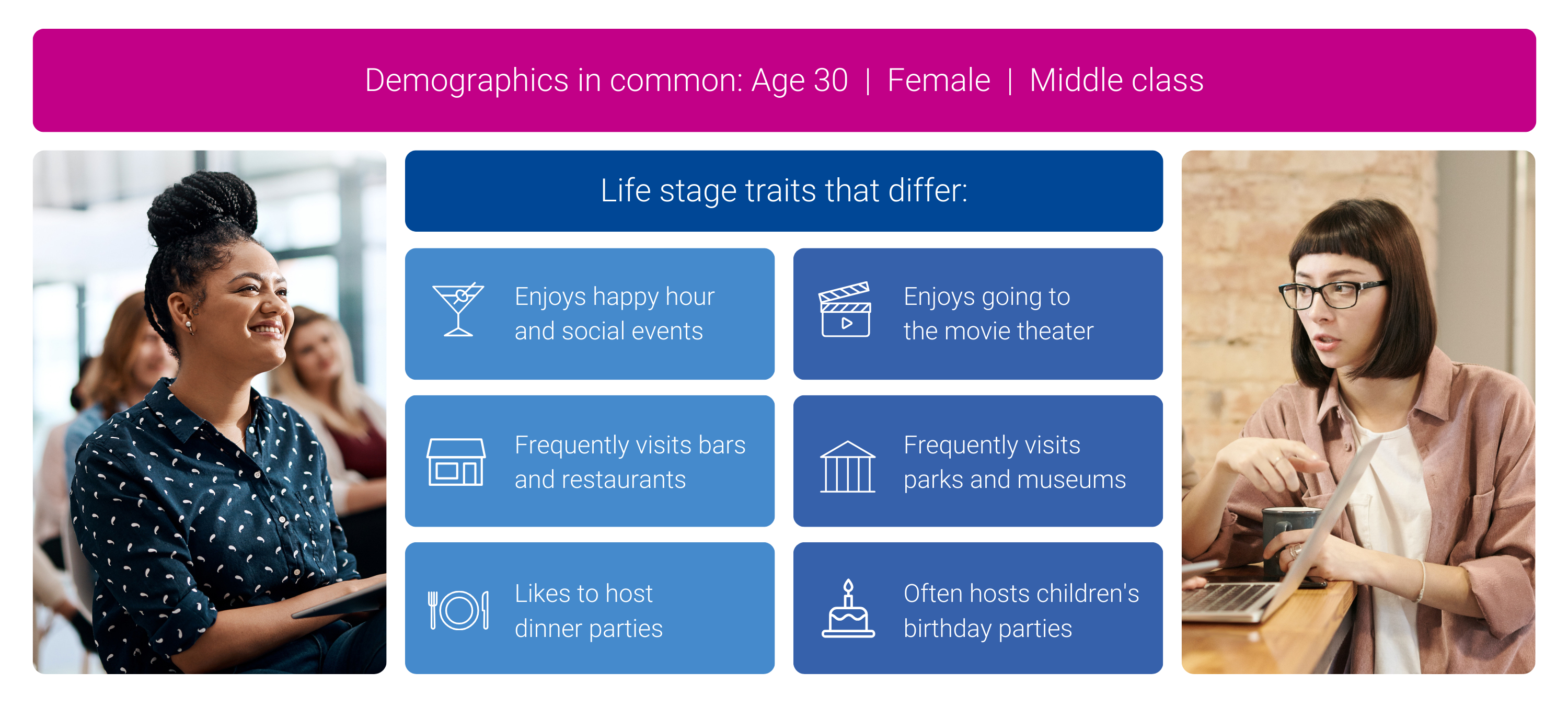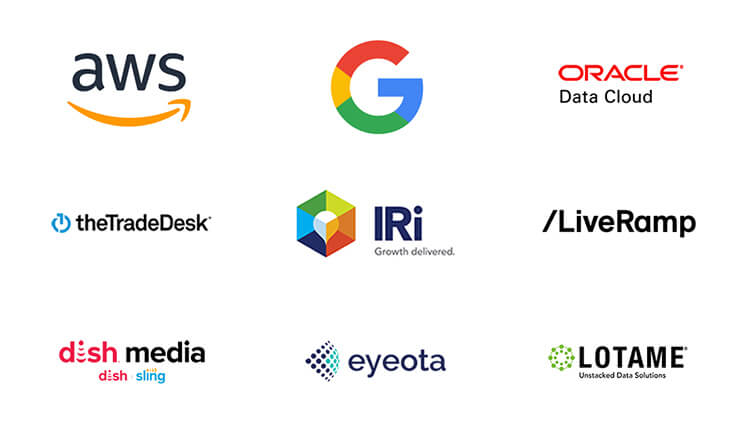Life stage segmentation in marketing
Engage your audiences through life’s milestones
Life stage segmentation or life stage marketing is a marketing strategy that categorizes consumers into groups based on where they are in life — whether graduating college, getting married, having children, or retiring — and the various behaviors and interests they exhibit in that stage. Consumers at different life stages have unique needs, preferences, and purchasing behaviors, even if they are of the same age, tax bracket, or gender. The life stage segmentation approach helps marketers determine their audience segments' values, decision-making processes, and product or service expectations.
Segmenting your audience by life stage can pinpoint your brand's most valuable customers. By focusing on these high-value segments, you can optimize your marketing strategies to appeal to these people and maximize your bottom line.
Adjusting your marketing strategies to your audience's life stage helps you deliver more personalized, relevant messages and maximize your budget. This approach boosts campaign efficiency, improves the customer experience, and increases engagement and conversions.
Life stage marketing can clue you into your audience’s needs, preferences, and behaviors at different life stages so you can develop products and services that better address the unique desires of each segment.
Employing targeted marketing strategies and creating products and services that cater to life segments helps increase the value to customers over time. This can help you keep your customers engaged, improve loyalty, and bring in revenue in the long term.
Demographic and life stage segmentation are helpful marketing approaches that differ in how they categorize consumers. Demographic segmentation categorizes your audience based on age, cultural background, occupation, gender, income, or family role. On the other hand, life stage segmentation focuses on consumers' life stages and major life events, such as marriage or retirement.
While the goal of demographic segmentation is to target specific demographic groups with tailored marketing strategies, life stage segmentation considers a broader range of factors related to consumers' life transitions and seeks to understand consumers' needs and behaviors within their current life context.
To learn more about other types of segmentation, such as geographic segmentation and psychographic segmentation, visit our Audience page and learn how Experian can help you improve your audience strategy.
Consider two millennials who share similar demographics, such as age, gender, and income level, but whose life stages differ significantly. One woman is a single, social butterfly while the other is a married, recent mother of several children. It’s essential to know how to target these two individuals, given their similar demographics but different life stages.
To make a meaningful marketing connection with a mother of several children, you must keep in mind the stage of life that they are in and incorporate these characteristics into your messaging strategy. A messaging strategy geared towards a new mother will surely differ from the way you would engage with a single woman. For example, crafting a message to a new mother may cater to her busy schedule, whereas connecting with a fun-seeking socialite may incorporate language around social activities.
Marketers must use life stages like these to reach and connect with the right people at the right moments, with a relevant offer.

Consider two millennials who share similar demographics, such as age, gender, and income level, but whose life stages differ significantly. One woman is a single, social butterfly while the other is a married, recent mother of several children. It’s essential to know how to target these two individuals, given their similar demographics but different life stages.
To make a meaningful marketing connection with a mother of several children, you must keep in mind the stage of life that they are in and incorporate these characteristics into your messaging strategy. A messaging strategy geared towards a new mother will surely differ from the way you would engage with a single woman. For example, crafting a message to a new mother may cater to her busy schedule, whereas connecting with a fun-seeking socialite may incorporate language around social activities.
Marketers must use life stages like these to reach and connect with the right people at the right moments, with a relevant offer.
Here are some typical life stage segmentation categories and the things that often matter to each segment. This information can help you to tailor your product and service offerings to this demographic's lifestyle and aspirations.
These are people who may be living on their own and might have recently graduated from college. They might be focused on establishing their career and their financial independence. This category can also include older, more established adults who have not recently graduated or don’t plan to get married soon. They’re likely to be most interested in furniture, basic appliances, affordable housing, and are drawn to lifestyle brands representing their identity.
To succeed in targeting these people, you should strive to understand their preferences for convenience-driven products and services, digital media consumption habits, career development interests, and financial priorities.
Recently married adults can range in age but are in the process of blending finances, households, families, and lifestyles. They may need to furnish their new shared space and are likely interested in affordable appliances and home goods. They’re also open to deals and promotions.
As a marketer targeting this category, you should aim to learn their preferences around wedding planning services, household items, financial planning tools, travel, and leisure activities.
New parents are adapting to a new family dynamic and will likely seek products that save them time and offer convenience. They’re most interested in child toys, clothes, food, family vehicles, and may be drawn to parenting content and communities. New parents are also very research-oriented and open to product recommendations from family and friends.
You should look into this category’s preferences and purchasing habits for family entertainment, childcare services, home improvement, and baby products.
Empty nesters have finished raising their children and have newfound time for their personal interests. They’re planning for retirement and may want to downsize their housing and possessions. They may also be interested in financial planning and travel and are more likely to have higher disposable income than new parents, newlyweds, and independent adults.
Try to discover empty nesters’ lifestyle preferences, including their travel and leisure interests, home renovation or downsizing tendencies, and the hobbies and interests that pertain most closely to your offerings.
Retirees are living on a fixed income and are more selective about their purchases. Their priorities are family time, leisure activities, and looking for senior discounts and travel deals. They’re drawn to nostalgic brands and causes related to their life passions.
With this category, knowing their healthcare requirements, financial needs, leisure preferences, and technology adoption habits is useful.
Zero-party data refers to the information consumers voluntarily share with businesses. This data is collected directly from customers through surveys and feedback forms. It provides a useful look into customers' life stages, preferences, and behaviors. Marketers can use this data to plan their strategies more effectively based on customers' explicit input.
Second- and third-party data sources can also help you improve your life stage segmentation efforts. Second-party data is collected through direct partnerships with other companies, while third-party data comes from external sources. You can collaborate with partners and access external sources to enrich your first-party data and craft robust segmentation strategies.
Experian offers over 2,400 unique audience segments tailored to various life stages through its syndicated audience segments. These segments are available across 30+ platforms, which makes it easy to target your audience effectively. Visit our audience webpage for more information on available segments and how they can enhance your marketing efforts.
First-party data is the information your company actively collects about your customers. This includes their online and offline activity, purchases, and habits. To effectively track this data, it’s crucial to develop clear goals. You can also work with Experian to enrich and enhance your first-party data. You can create more detailed audience segments by augmenting your data with Experian's vast datasets. These segments can then be easily delivered to over 200 media platforms for targeted marketing campaigns.
When using life stage segmentation, it’s important to exercise caution, making sure your segmentation strategy is free from age biases, focuses on relevant segments, allows for adaptability, considers granularity, and relies on quality data.
Be mindful of stereotypes associated with different age groups and avoid making assumptions about individuals based solely on their age. Relying on age-based segmentation alone can lead to biases and overlook the diverse needs and behaviors within groups. Consider, for example, how the newlywed category can comprise adults of all ages. Recognize the diversity within each life stage segment and change your messaging as needed.
Select the audience segments that most closely align with your target customers' characteristics and preferences. Customize your segmentation strategy to match your audience's needs and interests to ensure your marketing efforts resonate.
Consumer preferences and behaviors are always evolving, so your segmentation approach should be flexible and allow you to adapt to changing market dynamics. Monitor your segmentation strategy continuously and make adjustments to remain effective and relevant.
Determine the level of granularity required to target and personalize your marketing campaigns effectively. Balance segmentation depth with practical considerations so your segmentation strategy yields actionable insights without becoming overly complex.
You need high-quality data sources to inform your segmentation efforts. Fortunately, Experian offers a wealth of accurate and reliable data to enhance your segmentation strategy. By drawing on our data expertise, you can ensure the integrity and effectiveness of your audience segments and make your marketing campaigns more impactful.
Experian’s attribute rich marketing data provides your business with abundant opportunities to improve its segmentation strategy and customer engagement efforts.
We can help you identify and segment the right audience based on life stages, or other consumer attributes. Build new custom audience segments using Experian Marketing Data, or enhance your first-party data by adding valuable insights to create more comprehensive life stage segments and better understand your customer base. Our extensive partnerships enable us to deliver your audience segments across TV, advanced TV, open web, mobile, and more channels.
Choose one of our pre-built audiences, available in activation platforms, when you launch your next campaign. Experian’s pre-built audience segments enhance targeting, reach, and engagement in marketing campaigns. Choose accurate, high quality data to power your marketing initiatives.
Life stage segmentation gives marketers a powerful tool to understand and engage with consumers throughout life’s milestones. Using Experian's marketing data, businesses can target more accurate and effective life stage segments, which enables personalized marketing strategies that resonate.
Whether it's identifying valuable customers, delivering relevant marketing messages, or developing better products and services, Experian's data-driven solutions can drive improved customer engagement and, ultimately, business success.

This site is protected by reCAPTCHA and the Google Privacy Policy and Terms of Service apply.